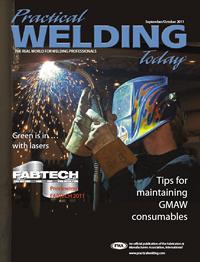Senior Sales Application Engineer
- FMA
- The Fabricator
- FABTECH
- Canadian Metalworking
Categories
- Additive Manufacturing
- Aluminum Welding
- Arc Welding
- Assembly and Joining
- Automation and Robotics
- Bending and Forming
- Consumables
- Cutting and Weld Prep
- Electric Vehicles
- En Español
- Finishing
- Hydroforming
- Laser Cutting
- Laser Welding
- Machining
- Manufacturing Software
- Materials Handling
- Metals/Materials
- Oxyfuel Cutting
- Plasma Cutting
- Power Tools
- Punching and Other Holemaking
- Roll Forming
- Safety
- Sawing
- Shearing
- Shop Management
- Testing and Measuring
- Tube and Pipe Fabrication
- Tube and Pipe Production
- Waterjet Cutting
Industry Directory
Webcasts
Podcasts
FAB 40
Advertise
Subscribe
Account Login
Search
Consumables Corner: Issues with incomplete fusion
- By Jay Ginder and Jerry Mathison
- June 27, 2014
- Article
- Consumables
Q: Recently our shop started using metal-cored wire. On one side we perform full-penetration welds to D1.1 structural code on 3/4- to 1-1/2-in.-thick plate. On the second side we carbon-arc-gouge to clean the metal and then we do a magnetic particle inspection before welding. We encounter two problems regularly—incomplete fusion and linear indications. Our wire feed speed (WFS) and voltage are the same on the second side as they are on the first. What’s wrong?
A: The groove angle on the back side of your gouged part may not allow easy access to the root. In other words, is your contact-tip-to-work distance (CTTW) on the gouged side the same width as onthe first side? If it is not, this could be a major contributor to the cause of your defects. While you may be duplicating the WFS and voltage, if your CTTW distance increases, your amperage will decrease at the same WFS. For example, if you use a 0.045-in.-dia. metal-cored wire set at 400 IPM and 28 volts with a ½-in. CTTW distance, your amperage will drop by an average of 60 to 70 amps when you increase your CTTW distance to 1 in.
Regardless of your wire diameter, you’ll see a drop in amperage and a slight increase in voltage as you increase CTTW distance from the original setting. This lower arc energy will not penetrate as well and could lead to poor sidewall fusion. To fix this you will need to start gouging a wider groove to allow for sufficient access to achieve the desired CTTW distance. If you don’t want to gouge a wider groove, you can increase the WFS to match the amperage used on the first side with the longer CTTW. If your welding procedure specification (WPS) won’t allow enough adjustment to match the amperage, you may have to develop a new WPS. If your CTTW distance is beyond what’s allowed per your WPS, you will have to increase the back-gouge groove angle until you meet the CTTW distance requirement.
Another possible cause of the second-side weld defect is your travel speed on the first pass. Carrying a larger weld puddle on the first pass will diminish the penetration and possibly cause a defect. The first pass on the second side should be small enough to penetrate the root and tie into the sides. You can then lower the travel speed on the second pass. Also, you have not mentioned what shielding gas you are using.
If you are using a higher argon percentage, the arc becomes soft and may not achieve deep penetration. This is caused by a slower travel speed in the root pass and the larger puddle actually insulating the arc energy. Remember to stay close to the leading edge of the puddle when welding the root pass or the first pass in a back-gouged joint puddle. In other words, keep the electrode feeding into the leading edge of the puddle in the direction of travel. This will help to ensure good penetration and sidewall fusion.
A frequently asked question from welders using metal-cored wires is whether to push or pull in reference to the torch angle. Either technique will produce acceptable results as long as you stay on the leading edge of the puddle and the angle isn’t excessive. Try to maintain at least 5 to 10 degrees from the vertical regardless which technique you use.
About the Authors
Jay Ginder
Filler Metal Manufacturing Center 801 Wilson Ave.
Hanover, PA 17331
Jerry Mathison
Senior Sales Application Engineer
411 S. Ebenezer Road
Florence, SC 29501
843-669-4411
About the Publication
Related Companies
subscribe now

The Welder, formerly known as Practical Welding Today, is a showcase of the real people who make the products we use and work with every day. This magazine has served the welding community in North America well for more than 20 years.
start your free subscription- Stay connected from anywhere

Easily access valuable industry resources now with full access to the digital edition of The Fabricator.

Easily access valuable industry resources now with full access to the digital edition of The Welder.

Easily access valuable industry resources now with full access to the digital edition of The Tube and Pipe Journal.
- Podcasting
- Podcast:
- The Fabricator Podcast
- Published:
- 04/16/2024
- Running Time:
- 63:29
In this episode of The Fabricator Podcast, Caleb Chamberlain, co-founder and CEO of OSH Cut, discusses his company’s...
- Industry Events
16th Annual Safety Conference
- April 30 - May 1, 2024
- Elgin,
Pipe and Tube Conference
- May 21 - 22, 2024
- Omaha, NE
World-Class Roll Forming Workshop
- June 5 - 6, 2024
- Louisville, KY
Advanced Laser Application Workshop
- June 25 - 27, 2024
- Novi, MI
































